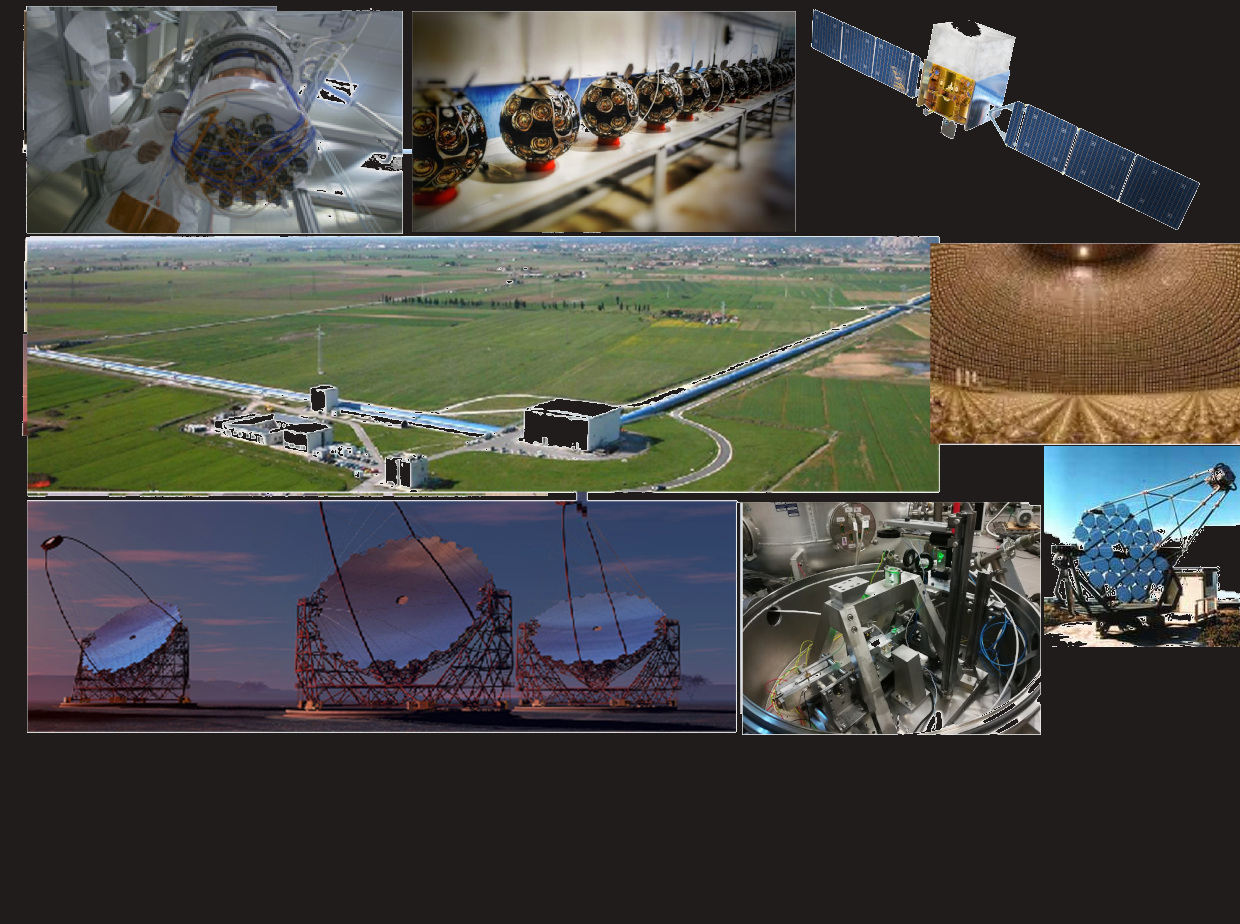Astroparticle physics

Coordinator Prof. Fabio GARUFI
The section unifies and coordinates all the research activities in the field of astroparticle physics and multiple messengers providing information from the cosmos. Its primary objective is the verification of grand unification theories of fundamental interactions and the quest for new types of matter and energy in the Universe, by profiting the natural laboratory offered by the Cosmos.
The experiments in astroparticle physics study the fundamental interactions, the radiation and the particles from space with experiences based in laboratories on ground, underground, in the depths of sea and on high altitudes up to space. The principal research lines present in our department are:
- Study of neutrino properties
- Study of cosmic radiation
- Study of Dark Universe
- Search for Gravitational waves and physics of gravitation
- General and quantum physics
- Research and innovation
The search for signals of new physics with respect to the Standard Models of Universe and of fundamental interactions is common to all the above mentioned research lines.
Present and future programs are based on a long tradition of experimental activities developed in the Department, but not only, on pa article and astroparticle physics and on development of technologies common to the different scientific lines in full integration with the researchers of the Napoli INFN Section and other sections and organizations.
Many tasks of the section are carried out in collaboration with national and international partners and the groups within the section are involved in research remaining competitive in a rapidly changing environment.
The activities in progress find their natural evolution in long durance international big projects, that will characterize scientific activities in the next decade and beyond.
Neutrino physics counts big projects as e.g. the deep underwater telescope KM3NeT, representing the contact point with cosmic-rays physics, DUNE and HyperKamiokande. The possibility of neutrino being a Majorana particle, is explored by the LEGEND experiment through the neutrinoless double beta decay.
Cosmic rays physics have various groups working in consolidates activities on the ground, as CTA or the Pierre Auger Observatory, in the depths of the sea,as said above, and is considering with great interest future initiatives in the space e.g. HERD or Crystal Eye besides the space activities already running.
The search for dark matter, one of the pillars of INFN of the Gran Sasso laboratories, is well rooted in our local groups, having recently concluded the mandate as national leader of the DarkSide experiment, where still accounts for high relevance roles.
Gravitational waves detection and multi-messenger observation of neutron stars coalescence, gave great momentum to the activities of the section, in particular the group within the LIGO-Virgo-Kagra (LVK) collaboration, with a natural evolution towards the activities for the development of the 3rd generation interferometer Einstein Telescope (ET).
As for gravity physics, Liquid actuated Gravity (LAG), aims at verifying possible deviations from the inverse square law of gravity.
The research in general and quantum physics see the section active with, e.g., the Archimedes experiment, looking at the links of General Relativity and quantistic vacuum, with the national leadership.
LIST OF ACTIVITIES
- Archimedes, Resp. nazionale: Annalisa Allocca; Resp. locale: Luciano Errico
- Auger, Resp. Roberta Colalillo
- Cherenkov Telescope Array (CTA) (resp. Carla Aramo (INFN), rif. Dip. Tristano DI GIROLAMO)
- WINK/Crystal Eye, Resp. Roberta Colalillo
- Darkside, resp. Giuliana FIORILLO,
- Einstein Telescope (ET), Resp. locale Antonino Chiummo
- GAPS, Resp. Donatella Campana (INFN), rif Dip. Valentina Scotti
- GERDA/LEGEND, Resp. Nicola Canci(INFN),Rif.Dip. Francesco Di Capua
- GINGER, [Resp. Alberto Porzio (UNICAS),] rif. dip. Raffaele Velotta
- HERD, Resp. Beatrice Panico
- JEM-EUSO, Resp. Giuseppe Osteria (INFN)
- KM3NeT,Telescopio sottomarino nel Mediterraneo per rivelazione di neutrini cosmici, Resp. Pasquale Migliozzi (INFN), rif. Dip. Antonio Marinelli
- Liquid (Mercury) Actuated Gravity (LAG/MAG), Resp. locale Rosario De Rosa
- LIMADOU, Resp. Valentina Scotti
- T2K e progetti futuri per la ricerca di oscillazioni di neutrino a JPARC (Giappone), resp. Antonio Di Nitto
- SPB2, Resp. Giuseppe Osteria (INFN)
- SWGO, Resp. Laura Valore
- VIRGO, resp. Valeria Sequino
- XENON, Resp. Stefano Mastroianni, ref. dip. Michele Iacovacci
- Research and innovtion activities